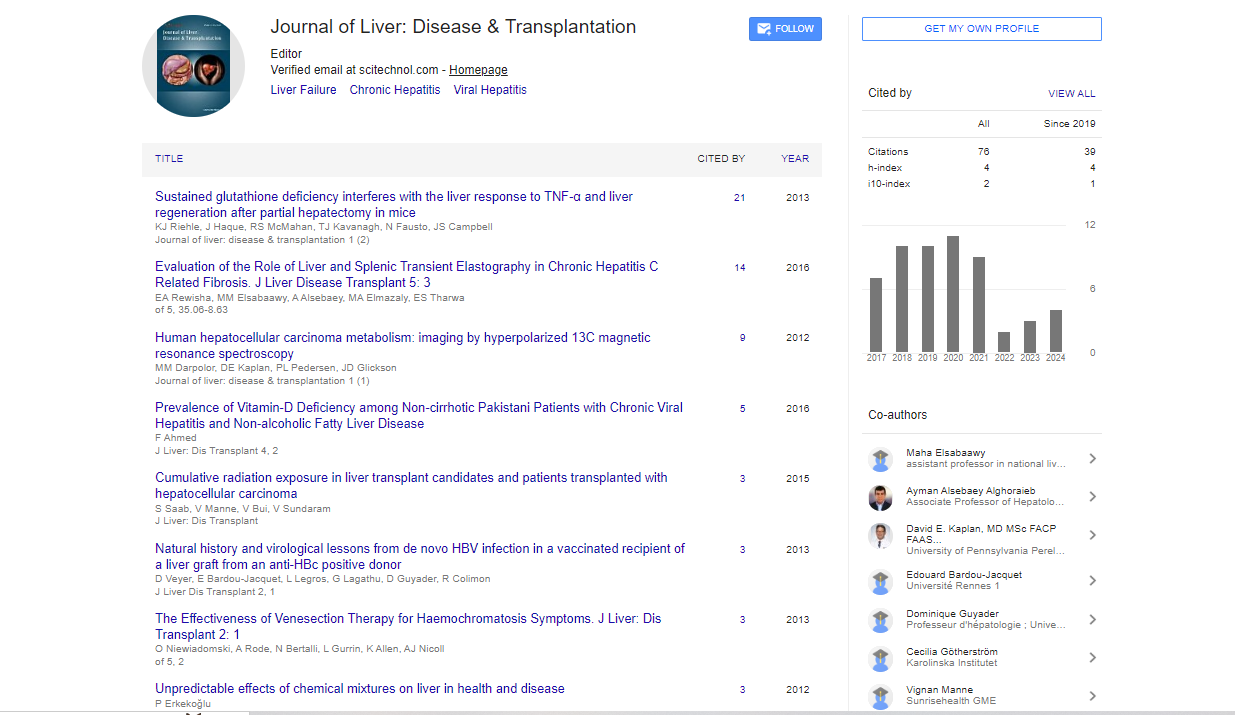Opinion Article, J Liver Disease Transplant Vol: 13 Issue: 3
Artificial Intelligence and Machine Learning Applications in Predicting Liver Disease Progression
Benjamin Harris*
1Department of Hepatology, University of Amsterdam, Amsterdam, The Netherlands
*Corresponding Author: Benjamin Harris,
Department of Hepatology, University
of Amsterdam, Amsterdam, The Netherlands
E-mail: benjamin.harris@uva.nl
Received date: 26 August, 2024, Manuscript No. JLDT-24-151920;
Editor assigned date: 28 August, 2024, PreQC No. JLDT-24-151920 (PQ);
Reviewed date: 11 September, 2024, QC No. JLDT-24-151920;
Revised date: 18 September, 2024, Manuscript No. JLDT-24-151920 (R);
Published date: 25 September, 2024, DOI: 10.4172/2325-9612.1000273
Citation: Harris B (2024) Artificial Intelligence and Machine Learning Applications in Predicting Liver Disease Progression. J Liver Disease Transplant 13:3.
Abstract
Description
In recent years, the fields of Artificial Intelligence (AI) and Machine Learning (ML) have shown remarkable potential in healthcare, especially in predicting disease progression. Among these applications, the prediction of liver disease progression has become a key focus due to the increasing prevalence of liver disorders worldwide, including chronic liver disease, hepatitis and cirrhosis. AI and ML have proven instrumental in early detection, prognosis and personalized treatment planning for patients, helping clinicians make more informed decisions. Liver disease is a broad term which includes various conditions, including viral hepatitis, fatty liver disease, cirrhosis and liver cancer. Liver disease can lead to serious complications, particularly in the later stages. Early diagnosis and accurate prediction of disease progression are important as they enable timely intervention and potentially improve patient outcomes. Traditional methods for diagnosing and predicting liver disease progression, such as liver biopsies and blood tests, can be invasive, costly and sometimes insufficiently sensitive to detect early changes. AI and ML approaches offer new ways to enhance the accuracy and efficiency of liver disease diagnosis and prognosis, providing data driven insights from large datasets that are difficult for clinicians to analyze manually.
Machine learning models, particularly supervised learning methods, have been widely applied in liver disease study. Supervised learning involves training algorithms on labeled datasets where input features (such as liver enzyme levels, age, body mass index and genetic markers) are associated with known outcomes. Some commonly used ML models for predicting liver disease include Support Vector Machines (SVM) and neural networks. These models can be trained to detect subtle patterns that are invisible to the human eye, offering improved diagnostic accuracy for liver disease progression. AI has made significant strides in liver imaging analysis, particularly in the interpretation of scans and ultrasound images. Image-based AI algorithms, such as Convolutional Neural Networks (CNNs), have been developed to detect fibrosis, cirrhosis and liver tumors. These algorithms can assess disease severity by examining the texture, shape and other features within liver images. In some cases, AI can even predict the likelihood of disease progression by analyzing subtle changes in liver tissue over time.
For instance, a CNN-based model might analyze sequential liver images from a patient with Non-Alcoholic Fatty Liver Disease (NAFLD) to detect early signs of fibrosis. This allows for a more precise estimation of disease progression and guides the decisionmaking process for treatment options, such as lifestyle interventions or medications. By automating image analysis, AI can save time and reduce subjectivity, allowing radiologists and hepatologists to focus on cases that require urgent attention. Natural Language Processing (NLP), a branch of AI focused on analyzing human language, has also shown promise in liver disease prediction. Many medical records contain unstructured data, including clinical notes, biopsy reports and patient histories. NLP algorithms can extract valuable information from these records, identifying patterns and risk factors associated with liver disease progression.
Conclusion
AI and ML have opened as new diagnostic methods for predicting liver disease progression, offering significant potential to improve diagnostic accuracy, enable personalized treatment and ultimately enhance patient care. While there are challenges to be addressed, including data quality and model transparency, the continued advancement of AI and ML technologies promises to make a meaningful impact on liver disease management. As study progresses, AI-driven predictive models are likely to become an invaluable tool in the fight against liver disease, helping clinicians to provide timely, targeted interventions and potentially transforming the standard of care.
 Spanish
Spanish  Chinese
Chinese  Russian
Russian  German
German  French
French  Japanese
Japanese  Portuguese
Portuguese  Hindi
Hindi 